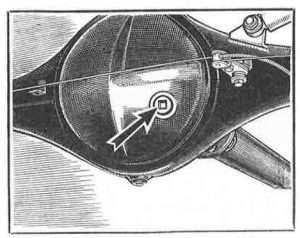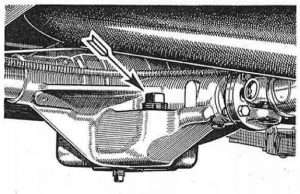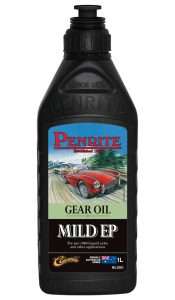Differential Oil – make that change
John McAdam
I am still in the process of getting to know our Riley 1.5. Part of this ‘honeymoon’ stage is changing all the fluids. As expected the original maintenance schedule is typical of the era, so the differential oil should be changed at 6000 mile intervals.* Unless you use the car as a daily driver this is a long time, and I’m guessing many of us don’t get round to ‘that oil change’ unless the diff gets grumbly. Like the gearbox, there is a lot of moving and meshing, squeezing and crushing parts in the differential and the oil gets hot and cools after each decent run. At a molecular level the oil and its various additives age (just like us, and the oil in your kitchen too), and with each heat/cool cycle, warm air gets pushed out and cooler moist air sucked back in through the small breather on top of the axle.** So the 3 reasons why you should change the diff oil:
- replace the aged oil
- remove accumulated moisture
- remove metal wear particles
Oils are continually improving and therein lies a problem. In the past, anything with EP90 on the label would probably do the job, but with the ever higher mechanical demands from todays’ machinery, diff oil formulations are carrying ever higher levels of extreme pressure (EP) additives and will usually say they conform to API (American Petroleum Institute) GL-5 or even GL-6. This specification relates to mechanical performance and has nothing to do with the underlying chemistry of the ingredients. For shearing steel on steel, this is great news, but most of our cars will have bronze thrust washers behind the planet gears, and it turns out that some of these additives are damaging to ‘yellow’ metals. If you search the internet you will find hundreds of pages discussing EP additives, particularly something called ‘active sulphur’.
Putting my scientist hat on I would suggest you ignore most of it; talk to me at a club run instead. The oil industry is of course much more interested in selling oil to the mass market and not our classic fleet. The result is that they will upsell the benefits of the new mechanical performance and minimise discussion of the chemistry. Phrases like “Exceeds GL-4 and GL-5” are common – of course if it meets GL-5 it will exceed GL-4!
If your diff is in good condition, you change the oil regularly and don’t drive like Jim Chrystall you may be perfectly fine with GL-5 spec oil. To be safer, find oil with the older GL-4 rating. This is not as easy as it sounds, but one oil company that appears to genuinely (!) support the veteran, vintage and classic car fleet is Penrite. I purchased their ‘Mild EP Gear Oil’. If you have a 4/44 or 1500 you’ll need a litre. Other Palmer cars and Farinas will need to buy a second bottle.
So make that oil change! Don’t forget to take the car for a nice run to get the oil warm (and thinner), but don’t burn yourself. Check for a filler plug before you drain the old. For most of you, this is on the rear of the axle. With the car on level ground fill till the oil comes out of this hole as fast as it goes in.
- This contribution was written particularly for those with 1950’s-70’s cars.
The general conclusions are likely to be valid for earlier cars too.
** If this breather gets blocked the trapped warm air will ‘encourage’ diff oil past your axle seals.
The 6/80 is similar – for access, remove the rear seat and circular cover plate. “…the axle should be filled to the level of the bottom thread of the orifice.”



